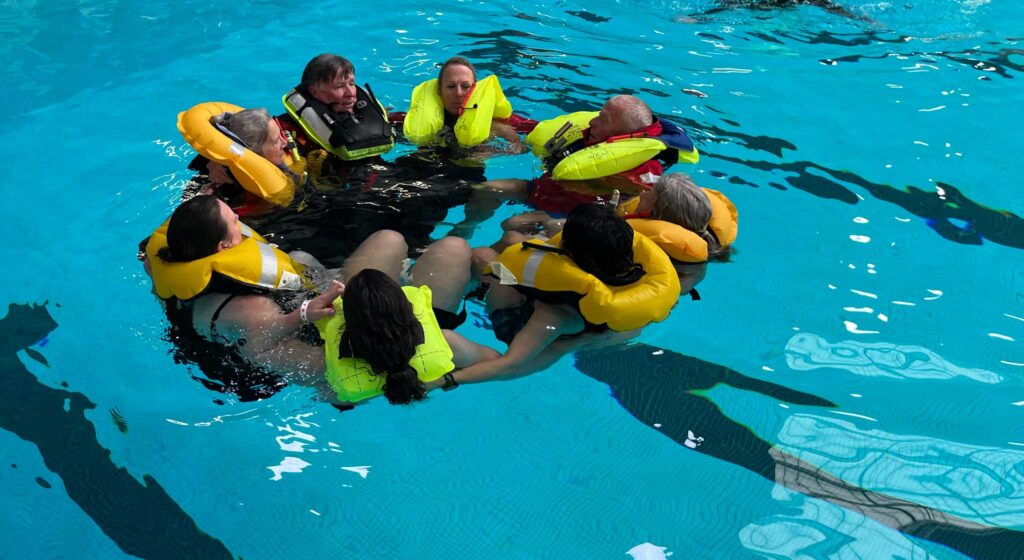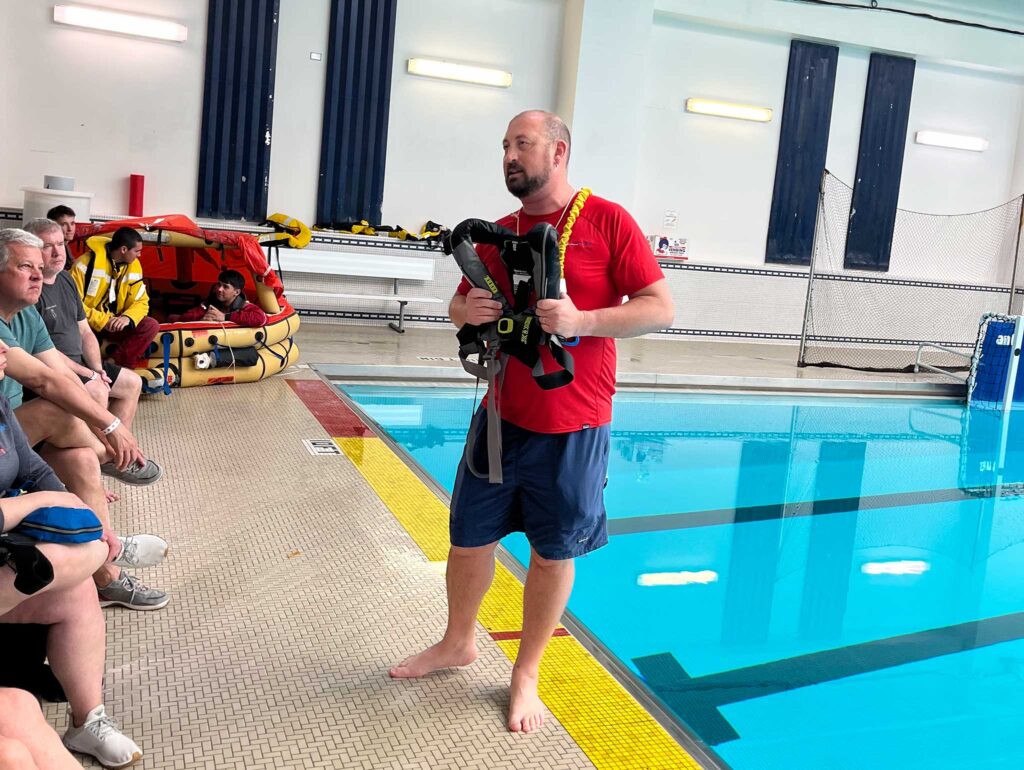
“Are you prepared.”
The query got here with no query mark on the finish, the nice and cozy however no-nonsense eyes of Jonathan Kabak wanting straight into mine.

“I feel so?” I answered, listening to the hesitation in my reply. I used to be standing beside the deep finish of a U.S. Naval Academy swimming pool, kitted up in new foulies, new seaboots, and a lifejacket I’d by no means used. I had one hand on the guide inflator tab—as a result of, as Jonathan had identified, if you happen to’re going within the water, you’d wish to know proper the place that’s, simply in case the self-inflating mechanism fails.
I had questions.

Like, will the inflator work? If it doesn’t…these new boots…will I sink like a streamlined brick? Are they going to have to avoid wasting me in entrance of all these different individuals? Will I freak out after I go below at that first bounce? What is going to all this really feel like? In all my time crusing, I’d by no means needed to discover out.
Jonathan, chair of the Moderator Working Group of US Crusing’s Security at Sea Committee, and captain of the sail coaching ship Oliver Hazard Perry in his day job, had probably seen these questions and extra racing by college students’ minds a couple of thousand instances. He quietly requested, “What’s regarding you?”
“New boots? Unsure what’s going to occur?” However, I made a decision, that’s what I’m right here for—to attempt to get a way of what’s going to occur. “Prepared.”

And I stepped off the pool deck, plunged down, and burst again to the floor, the pillows of the inflated vest doing their job and maintaining my head effectively above water. He helped clear a snag in the back of my vest, then I began studying methods to paddle round with all these things on (the boots have been nice—heat, buoyant, and simple to swim in), use the valve to regulate the vest’s inflation, and get kind of snug as I waited for the remainder of the category to make the leap, after which we might all transfer on to flipping a liferaft upright and studying what it feels wish to haul up into one and be inside.
In a wonderfully flat, calm, indoor pool. With strapping younger Navy lifeguards and lecturers like Jonathan standing by.

I didn’t discover it too laborious to walrus in, thanks to 2 classmates already serving to me. (Who goes within the raft first? The individuals or particular person most capable of assist others in.) However even in that setting, jammed into what the resident medical skilled known as the “floating vomitorium” with seven different individuals for a complete of perhaps 5 minutes was sufficient to make me by no means wish to be in a state of affairs the place I’d have to make use of one in anger. (Later, I learn a report of the sinking of the reproduction ship Bounty in Hurricane Sandy, and the survivors mentioned that within the violent situations after they deserted ship, it took as a lot as one hour for every of them to get into the liferaft. Most have been carrying cumbersome survival fits, and all have been already exhausted even earlier than they went into the water.)

For my group attending US Crusing’s Security at Sea seminar in Annapolis, offered by Navy Crusing and the Marine Trades Affiliation of Maryland (MTAM) final weekend, the pool workout routines have been the final piece of two days of intense persevering with schooling as sailors. It was the forty third Security at Sea seminar in Annapolis, with 17 instructors instructing 158 pupil sailors.
We discovered about climate, harm management methods, storm sails and heavy climate, emergency medical care, seasickness, communications, firefighting—all with real-life examples that gave us contemporary eyes. As an example, it’s good thought to stash a pair of fireproof gloves aboard, so in case your cellphone’s lithium battery catches hearth, you possibly can heave it overboard shortly; there’s no solution to put it out, and a hearth can double in dimension in 30 seconds. And, you recognize what’s an effective way to cease a leak? Wax rest room ring sealing materials—this tip got here from SAIL’s Technical Editor Adam Cove, who additionally led a hands-on harm management class that included organising a jury rig.
After instructors defined at school the sailhandling required for maneuvers like the short cease to retrieve somebody overboard, members of the Navy Crusing group executed the actual factor on the Severn River in Navy 44s. The spotlight was watching a U.S. Coast Guard MH-65 Dolphin helicopter method a Navy 44 with a simulated medical emergency requiring evacuation, hovering simply over the mast, and reducing after which retrieving a rescue swimmer and basket. (In case you questioned: Stash every part free beneath, earlier than the helo is overhead, as a result of the vortices of hurricane-force winds can suck a bit of substances upwards into the rotors and, as USCG Lt. Cdr. Kellen Browne, MH-60 pilot, wryly famous, “Our time working with you should have concluded.”)

By the weekend’s conclusion, I’d earned the Worldwide Offshore Crusing certification required for some crew in offshore races. Extra importantly, I gained a brand new perspective about security; you possibly can’t purchase it, you possibly can by no means cease studying extra about it, and—one other Jonathan mandate—your fingerprints needs to be throughout your security gear. And, I walked away with a brand new measure of confidence about points of crusing—offshore, coastal, and even in my dwelling Chesapeake Bay—that generally felt intimidating.
So subsequent time when somebody asks, “Are you prepared,” I’ll be so much nearer to with the ability to say, sure.


SAIL Editor-in-Chief Wendy Mitman Clarke logged some 30,000 bluewater miles throughout 4 and a half years of fulltime cruising on an Adams 45 along with her husband and two children. Rising up on the Chesapeake Bay, she has raced and cruised all method of sailboats over a lifetime of crusing, from Snipes and E-Scows to efficiency keelboats and bluewater passagemakers.
Trending Merchandise
[product_category category=”trending” per_page=”8″ columns=”2″ orderby=”date” order=”desc”].
